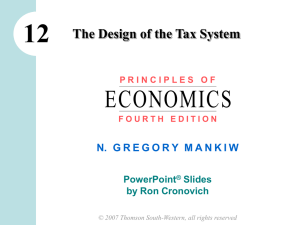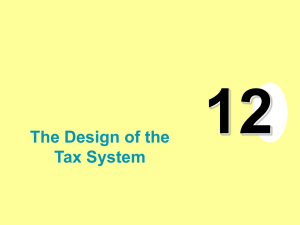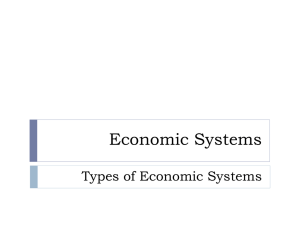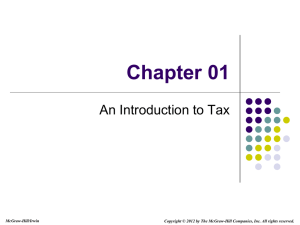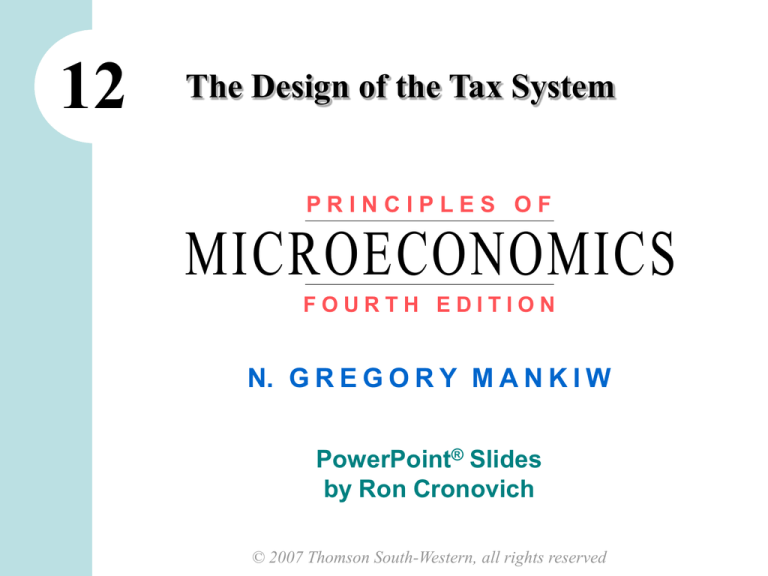
12
The Design of the Tax System
PRINCIPLES OF
MICROECONOMICS
FOURTH EDITION
N. G R E G O R Y M A N K I W
PowerPoint® Slides
by Ron Cronovich
© 2007 Thomson South-Western, all rights reserved
In this chapter, look for the answers to
these questions:
What are the largest sources of tax revenue in the
U.S.?
What are the efficiency costs of taxes?
How can we evaluate the equity of a tax system?
CHAPTER 12
THE DESIGN OF THE TAX SYSTEM
1
Introduction
One of the Ten Principles from Chapter 1:
A government can sometimes
improve market outcomes.
• providing public goods
• regulating use of common resources
• remedying the effects of externalities
To perform its many functions,
the govt raises revenue through taxation.
CHAPTER 12
THE DESIGN OF THE TAX SYSTEM
2
Introduction
Lessons about taxes from earlier chapters:
• A tax on a good reduces the market quantity
of that good.
• The burden of a tax is shared between buyers
and sellers depending on the price elasticities
of demand and supply.
• A tax causes a deadweight loss.
CHAPTER 12
THE DESIGN OF THE TAX SYSTEM
3
A Look at Taxation in the U.S.
First, we consider:
how tax revenue as a share of national income
has changed over time
how the U.S. compares to other countries with
respect to taxation
the most important revenue sources for federal,
state & local govt
CHAPTER 12
THE DESIGN OF THE TAX SYSTEM
4
U.S. Tax Revenue (% of GDP)
40%
35%
30%
25%
20%
15%
10%
5%
0%
1940
1950
1960
1970
State and local
CHAPTER 12
1980
1990
2000
Federal
THE DESIGN OF THE TAX SYSTEM
5
Central Govt Revenue (% of GDP)
CHAPTER 12
France
39%
United Kingdom
34
Germany
29
Brazil
20
United States
19
Canada
18
Russia
17
Pakistan
15
Indonesia
15
Mexico
13
India
10
THE DESIGN OF THE TAX SYSTEM
6
Receipts of the U.S. Federal Govt, 2004
Tax
Amount
(billions)
Individual income taxes
$ 809
$2,753
43%
Social insurance taxes
733
2,494
39
Corporate income taxes
189
643
10
Other
149
507
8
Total
$1,880
$6,397
CHAPTER 12
Amount
per person
THE DESIGN OF THE TAX SYSTEM
Percent
of Receipts
100%
7
Receipts of State & Local Govts, 2002
Tax
Sales taxes
Amount
(billions)
Amount
per person
Percent
of Receipts
$ 324
$1,102
Property taxes
279
949
17
Individual income taxes
203
690
12
Corporate income taxes
28
95
2
From federal govt
361
1,228
21
Other
490
1,667
29
Total
$1,685
$5,733
100%
CHAPTER 12
THE DESIGN OF THE TAX SYSTEM
19%
8
Taxes and Efficiency
One tax system is more efficient than another
if it raises the same amount of revenue
at a smaller cost to taxpayers.
The costs to taxpayers include:
• the tax payment itself
• deadweight losses
• administrative burden
CHAPTER 12
THE DESIGN OF THE TAX SYSTEM
9
Deadweight Losses
One of the Ten Principles:
People respond to incentives.
Recall from Chapter 8:
Taxes distort incentives, cause people to allocate
resources according to tax incentives rather than
true costs and benefits.
The result: a deadweight loss.
The fall in taxpayers’ well-being exceeds the
revenue the govt collects.
CHAPTER 12
THE DESIGN OF THE TAX SYSTEM
10
Income vs. Consumption Tax
The income tax reduces the incentive to save:
• If income tax rate = 25%,
8% interest rate = 6% after-tax interest rate
• The lost income compounds over time.
Some economists advocate taxing consumption
instead of income.
• would restore incentive to save
• better for individuals’ retirement income security
and long-run economic growth
CHAPTER 12
THE DESIGN OF THE TAX SYSTEM
11
Income vs. Consumption Tax
Consumption tax-like provisions in the U.S. tax
code include Individual Retirement Accounts,
401(k) plans.
• People can put a limited amount of saving into
such accounts.
• The funds are not taxed until withdrawn at
retirement.
Europe’s Value-Added Tax (VAT) is like a
consumption tax.
CHAPTER 12
THE DESIGN OF THE TAX SYSTEM
12
Administrative Burden
includes the time and money people spend to
comply with tax laws
encourages the expenditure of resources on
legal tax avoidance
• e.g., hiring accountants to exploit “loopholes”
to reduce one’s tax burden
is a type of deadweight loss
could be reduced if the tax code were simplified
but would require removing loopholes,
politically difficult
CHAPTER 12
THE DESIGN OF THE TAX SYSTEM
13
Marginal vs. Average Tax Rates
average tax rate
• total taxes paid divided by total income
• measures the sacrifice a taxpayer makes
marginal tax rate
• the extra taxes paid on an additional dollar of
income
• measures the incentive effects of taxes
on work effort, saving, etc.
CHAPTER 12
THE DESIGN OF THE TAX SYSTEM
14
Lump-Sum Taxes
A lump-sum tax is the same for every person
Example: lump-sum tax = $4000/person
income
average tax rate marginal tax rate
$20,000
20%
0%
$40,000
10%
0%
CHAPTER 12
THE DESIGN OF THE TAX SYSTEM
15
Lump-Sum Taxes
A lump-sum tax is the most efficient tax:
• causes no deadweight loss
does not distort incentives, as a person’s
decisions have no tax consequences
• minimal administrative burden
no need to hire accountants, keep track of
receipts, etc.
Yet, not used because perceived as unfair:
• in dollar terms, the poor pay as much as the rich
• relative to income, the poor pay much more than
the rich
CHAPTER 12
THE DESIGN OF THE TAX SYSTEM
16
Taxes and Equity
Another goal of tax policy: equity – distributing
the burden of taxes “fairly.”
Agreeing on what is “fair” is much harder than
agreeing on what is “efficient.”
Yet, there are several principles people apply
to evaluate the equity of a tax system.
CHAPTER 12
THE DESIGN OF THE TAX SYSTEM
17
The Benefits Principle
Benefits principle: the idea that people should
pay taxes based on the benefits they receive
from govt services
Tries to make public goods similar to private
goods – the more you use, the more you pay.
Example: Gasoline taxes
• the more you drive on public roads,
the more gas you buy,
so the more gas tax you pay
CHAPTER 12
THE DESIGN OF THE TAX SYSTEM
18
The Ability-To-Pay Principle
Ability-to-pay principle: the idea that taxes
should be levied on a person according to how
well that person can shoulder the burden
suggests that all taxpayers should make an
“equal sacrifice” to support govt
recognizes that the magnitude of the sacrifice
depends not just on the tax payment, but on the
person’s income and other circumstances
• a $10,000 tax bill is a bigger sacrifice for a
poor person than a rich person
CHAPTER 12
THE DESIGN OF THE TAX SYSTEM
19
Vertical Equity
Vertical equity: the idea that taxpayers with a
greater ability to pay taxes should pay larger
amounts
CHAPTER 12
THE DESIGN OF THE TAX SYSTEM
20
Three Tax Systems
Proportional tax: taxpayers pay the same
fraction of income, regardless of income
Regressive tax: high-income taxpayers pay a
smaller fraction of their income than low-income
taxpayers
Progressive tax: high-income taxpayers pay a
larger fraction of their income than low-income
taxpayers
CHAPTER 12
THE DESIGN OF THE TAX SYSTEM
21
Examples of the Three Tax Systems
regressive
income
tax
% of
income
$50,000 $15,000 30%
proportional
tax
% of
income
progressive
tax
% of
income
$12,500 25%
$10,000 20%
100,000
25,000 25
25,000 25
25,000 25
200,000
40,000 20
50,000 25
60,000 30
CHAPTER 12
THE DESIGN OF THE TAX SYSTEM
22
U.S. Federal Income Tax Rates: 2005
The U.S. has a
progressive
income tax.
CHAPTER 12
On taxable
income…
the tax rate
is…
0 – $7,300
10%
7,300 – 29,700
15%
29,700 – 71,950
25%
71,950 – 150,150
28%
150,150 – 326,450
33%
Over $326,450
35%
THE DESIGN OF THE TAX SYSTEM
23
Horizontal Equity
Horizontal equity: the idea that taxpayers with
similar abilities to pay taxes should pay the
same amount
Problem: Difficult to agree on what factors,
besides income, determine ability to pay.
CHAPTER 12
THE DESIGN OF THE TAX SYSTEM
24
Tax Incidence and Tax Equity
Recall: The person who bears the burden is not
always the person who gets the tax bill.
Example: A tax on fur coats
• May appear to be vertically equitable
• But furs are a luxury, with very elastic demand
• The tax shifts demand away from furs,
hurting the people who produce furs
(who probably are not rich)
Lesson: When evaluating tax equity, must take
tax incidence into account.
CHAPTER 12
THE DESIGN OF THE TAX SYSTEM
25
Who Pays the Corporate Income Tax?
When the govt levies a tax on a corporation,
the corporation is more like a tax collector
than a taxpayer.
The burden of the tax ultimately falls on people.
Suppose govt levies a tax on car companies
• owners receive less profit, may respond over time
•
•
by shifting their wealth out of the car industry
the supply of cars falls, car prices rise,
car buyers are worse off
demand for auto workers falls, wages fall,
workers are worse off
CHAPTER 12
THE DESIGN OF THE TAX SYSTEM
26
Flat Taxes
Flat tax: a tax system under which the marginal tax
rate is the same for all taxpayers
Typically, income above a certain threshold is
taxed at a constant rate.
The higher the threshold, the more progressive
the tax
Radically reduces administrative burden
Not popular with
• people who benefit from the complexity of the
current system (accountants, lobbyists)
• people who can’t imagine life without their
favorite deduction/loophole
Used in some central/eastern European countries
CHAPTER 12
THE DESIGN OF THE TAX SYSTEM
27
CONCLUSION: The Trade-Off Between
Efficiency and Equity
The goals of efficiency and equity often conflict:
• E.g., lump-sum tax is the least equitable but
most efficient tax.
Political leaders differ in their views on this
tradeoff.
Economics
• can help us better understand the tradeoff
• can help us avoid policies that sacrifice
efficiency without any increase in equity
CHAPTER 12
THE DESIGN OF THE TAX SYSTEM
28
CHAPTER SUMMARY
In the U.S., the most important federal revenue
sources are the personal income tax, social
insurance payroll taxes, and the corporate income
tax. The most important state and local taxes are
the sales tax and property tax.
The efficiency of a tax system refers to the costs it
imposes on taxpayers beyond their tax payments.
One cost is the deadweight loss caused by the
distortion of incentives from taxes. Another is the
administrative burden of complying with tax laws.
CHAPTER 12
THE DESIGN OF THE TAX SYSTEM
29
CHAPTER SUMMARY
The equity of a tax system refers to its fairness.
The benefits principle suggests that it is fair for
people to be taxed based on the amount of
government benefits they receive. The ability-topay principle suggests that it is fair for people to
pay taxes based on their ability to handle the
burden.
The U.S. has a progressive tax system, in which
high income taxpayers face a higher average tax
rate than low income taxpayers.
CHAPTER 12
THE DESIGN OF THE TAX SYSTEM
30
CHAPTER SUMMARY
When evaluating the equity of a tax system,
it is important to consider tax incidence, as the
distribution of tax burdens is not the same as the
distribution of tax bills.
Policymakers often face a tradeoff between the
goals of efficiency and equity in the tax system.
Much of the debate over tax policy arises because
people give different weights to these two goals.
CHAPTER 12
THE DESIGN OF THE TAX SYSTEM
31

